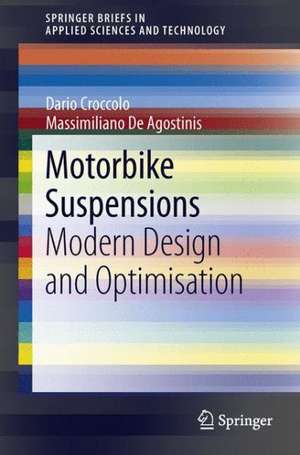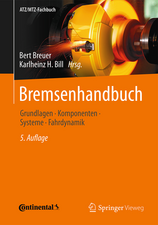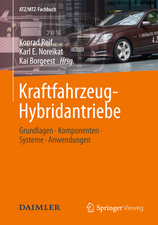Motorbike Suspensions: Modern design and optimisation: SpringerBriefs in Applied Sciences and Technology
Autor Dario Croccolo, Massimiliano Agostinisen Limba Engleză Paperback – 29 mai 2013
Utilizing the authors' many years of experience in this industrial research topic, Motorbike Suspensions provides useful design rules and applied mechanical design theories to optimize the shape of motorbike suspension. Overall structural considerations are explored alongside specific aspects including how bolted and adhesively bonded joints design can be applied to these components.
R&D designers in the motorcycle industry who would like to improve their knowledge about the structural design of motorbike suspension will find Motorbike Suspension a concise and coherent guide to this specific feature. Whereas, undergraduates and graduates in industrial engineering matters may use this as a case study for an interesting application of the theories learned from machine design courses.
Din seria SpringerBriefs in Applied Sciences and Technology
-
 Preț: 380.29 lei
Preț: 380.29 lei - 17%
 Preț: 360.34 lei
Preț: 360.34 lei - 20%
 Preț: 386.12 lei
Preț: 386.12 lei -
 Preț: 380.07 lei
Preț: 380.07 lei -
 Preț: 377.95 lei
Preț: 377.95 lei -
 Preț: 382.32 lei
Preț: 382.32 lei -
 Preț: 376.59 lei
Preț: 376.59 lei -
 Preț: 379.09 lei
Preț: 379.09 lei -
 Preț: 378.12 lei
Preț: 378.12 lei - 20%
 Preț: 293.83 lei
Preț: 293.83 lei -
 Preț: 344.90 lei
Preț: 344.90 lei -
 Preț: 321.36 lei
Preț: 321.36 lei -
 Preț: 264.79 lei
Preț: 264.79 lei -
 Preț: 344.90 lei
Preț: 344.90 lei -
 Preț: 356.46 lei
Preț: 356.46 lei -
 Preț: 382.95 lei
Preț: 382.95 lei -
 Preț: 355.66 lei
Preț: 355.66 lei -
 Preț: 479.67 lei
Preț: 479.67 lei -
 Preț: 415.18 lei
Preț: 415.18 lei -
 Preț: 444.52 lei
Preț: 444.52 lei - 20%
 Preț: 301.86 lei
Preț: 301.86 lei -
 Preț: 409.43 lei
Preț: 409.43 lei - 20%
 Preț: 322.17 lei
Preț: 322.17 lei -
 Preț: 355.49 lei
Preț: 355.49 lei - 15%
 Preț: 462.51 lei
Preț: 462.51 lei -
 Preț: 377.18 lei
Preț: 377.18 lei -
 Preț: 355.93 lei
Preț: 355.93 lei -
 Preț: 382.95 lei
Preț: 382.95 lei -
 Preț: 378.12 lei
Preț: 378.12 lei -
 Preț: 378.12 lei
Preț: 378.12 lei -
 Preț: 380.07 lei
Preț: 380.07 lei -
 Preț: 380.07 lei
Preț: 380.07 lei - 20%
 Preț: 326.28 lei
Preț: 326.28 lei -
 Preț: 312.68 lei
Preț: 312.68 lei -
 Preț: 356.43 lei
Preț: 356.43 lei -
 Preț: 412.30 lei
Preț: 412.30 lei - 20%
 Preț: 225.31 lei
Preț: 225.31 lei -
 Preț: 378.12 lei
Preț: 378.12 lei -
 Preț: 376.59 lei
Preț: 376.59 lei -
 Preț: 195.87 lei
Preț: 195.87 lei -
 Preț: 376.22 lei
Preț: 376.22 lei - 20%
 Preț: 324.64 lei
Preț: 324.64 lei - 20%
 Preț: 288.73 lei
Preț: 288.73 lei -
 Preț: 377.57 lei
Preț: 377.57 lei -
 Preț: 261.91 lei
Preț: 261.91 lei -
 Preț: 381.98 lei
Preț: 381.98 lei -
 Preț: 273.64 lei
Preț: 273.64 lei -
 Preț: 410.87 lei
Preț: 410.87 lei -
 Preț: 379.68 lei
Preț: 379.68 lei -
 Preț: 374.30 lei
Preț: 374.30 lei
Preț: 406.10 lei
Nou
Puncte Express: 609
Preț estimativ în valută:
77.71€ • 83.10$ • 64.79£
77.71€ • 83.10$ • 64.79£
Carte tipărită la comandă
Livrare economică 14-19 aprilie
Preluare comenzi: 021 569.72.76
Specificații
ISBN-13: 9781447151487
ISBN-10: 1447151488
Pagini: 116
Ilustrații: VII, 105 p. 98 illus.
Dimensiuni: 155 x 235 x 6 mm
Greutate: 0.17 kg
Ediția:2013
Editura: SPRINGER LONDON
Colecția Springer
Seria SpringerBriefs in Applied Sciences and Technology
Locul publicării:London, United Kingdom
ISBN-10: 1447151488
Pagini: 116
Ilustrații: VII, 105 p. 98 illus.
Dimensiuni: 155 x 235 x 6 mm
Greutate: 0.17 kg
Ediția:2013
Editura: SPRINGER LONDON
Colecția Springer
Seria SpringerBriefs in Applied Sciences and Technology
Locul publicării:London, United Kingdom
Public țintă
Professional/practitionerCuprins
1.Motorbike equilibrium.- 2.The rear suspension equilibrium .- 3.Example of loads and stresses acting on the rear suspension.- 4.The front suspension.
Notă biografică
Dario Croccolo gained his1st class degree in Mechanical Engineering in 1990 and qualified as an Engineer with full marks in1991. In 1992 he qualified as a Ropeways Director and obtained his PhD in 1994. From 1992 to 1995 he acted as Professor of “Production Technology” at the “A. Meucci” Technical Secondary School (Cittadella – Italy) and became Assistant Professor in 1995 at the University of Bologna, where he is attached to the DIN Department.In 2001 he became an Associate Professor of Machine Design.
Since 1996 Prof. Croccolo has been in charge of the DIN Library, and in 2007 he was made Director of the Italian Design Summer School: art, society and industry supported by agreements between the University of Bologna, the University of Osaka (Japan), the Yuan Ze University (Taiwan) and the Tongji University (China). He was also involved, as scientific Coordinator, in several research activities carried out in cooperation with some important industrial companies. Since 1999 he has been in charge of the Erasmus exchange program between the University of Limerick and the University of Bologna. The research activity is mainly focused on the following fields: shaft-hub connection, threaded connection, friction coefficient definition, fatigue behaviour of materials, adhesive bolted and interference fit joints (hybrid joints). He is author of more than 120 publications, including four monographs (two of them as international editions), three contributions to book chapters, as international editions, some papers presented at national and international Conferences, some manuscripts submitted to national and international journals of which 28are included in ISI or SCOPUS databases.
Massimiliano De Agostinis gained his Masters Degree in Mechanical Engineering from the University of Bologna in 2007 and obtained hsi PhD in Machine Design from the University of Firenze in 2013. As research assistant at the Department of Industrial Engineering of the University of Bologna, his research activities focus on mechanical joining techniques. As a technical advisor, he took part in the design of several products in the field of motorbike suspensions.
Since 1996 Prof. Croccolo has been in charge of the DIN Library, and in 2007 he was made Director of the Italian Design Summer School: art, society and industry supported by agreements between the University of Bologna, the University of Osaka (Japan), the Yuan Ze University (Taiwan) and the Tongji University (China). He was also involved, as scientific Coordinator, in several research activities carried out in cooperation with some important industrial companies. Since 1999 he has been in charge of the Erasmus exchange program between the University of Limerick and the University of Bologna. The research activity is mainly focused on the following fields: shaft-hub connection, threaded connection, friction coefficient definition, fatigue behaviour of materials, adhesive bolted and interference fit joints (hybrid joints). He is author of more than 120 publications, including four monographs (two of them as international editions), three contributions to book chapters, as international editions, some papers presented at national and international Conferences, some manuscripts submitted to national and international journals of which 28are included in ISI or SCOPUS databases.
Massimiliano De Agostinis gained his Masters Degree in Mechanical Engineering from the University of Bologna in 2007 and obtained hsi PhD in Machine Design from the University of Firenze in 2013. As research assistant at the Department of Industrial Engineering of the University of Bologna, his research activities focus on mechanical joining techniques. As a technical advisor, he took part in the design of several products in the field of motorbike suspensions.
Textul de pe ultima copertă
This book addresses the fundamental aspects of the structural design of a motorbike fork. Although it may look as a simple component, the motorbike fork plays a critical role in the overall dynamic behaviour of motorcycles. It must provide appropriate stiffness characteristics, damping capabilities and the lowest sliding friction values in order to guarantee as much performance, safety and comfort as possible to the rider. From a structural mechanics standpoint, the main frame of motorbike forks usually consists of two legs, two steering plates and a steering pin, joined by means of several shaft-hub couplings. Based on the authors' many years of experience in this industrial research topic, the aim of this book is to provide the reader with useful design rules and hints oriented to the shape optimization of motorbike forks, ranging from overall structural considerations to bolted and adhesively bonded joints design applied to the fork components. The book is oriented to R&D designers in the motorcycle industry who would like to improve their knowledge about the structural design of a motorbike fork, as well as to undergraduates and graduates in industrial engineering matters who would like to see an interesting application of the theories learned from machine design courses.
Caracteristici
Addresses the fundamental aspects of the structural design of a motorbike fork to illustrate its critical role in the overall dynamic behaviour of motorcycles Draws on authors year of experience to provide the reader with useful design rules and hints oriented to the shape optimization of motorbike forks, ranging from overall structural considerations to bolted and adhesively bonded joints design applied to the fork components Illustrates practical applications of the theories learned from machine design courses
















